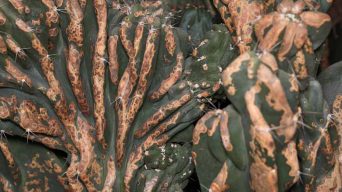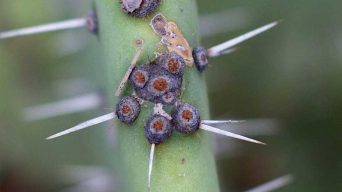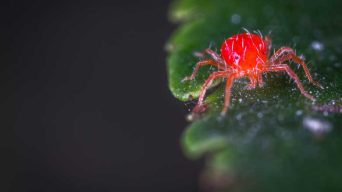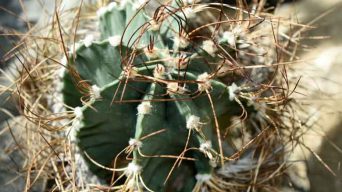To treat black spots on cactus plants, identify the cause (fungi, bacteria, chemicals, pests, rot, sun or leaf spot damage). For fungi and bacteria, use appropriate fungicides or antibiotics. Prune affected areas, ensure proper watering, avoid chemical damage, and protect from excess sun. Keep the plant quarantined if pests are present and repot if rot is detected. Regular care and preventive measures are crucial.
Many cactus owners encounter the issue of black spots, which can spread across the entire plant and potentially lead to its demise.
However, there are straightforward solutions to address this problem effectively.
This article will provide detailed instructions on treating black spots on your cactus, ensuring you can manage this issue effortlessly.
Identifying and Addressing Cacti With Black Spots
Cacti and succulents often encounter a common issue: black spots. If left untreated, these spots can compromise the plant’s health, appearance, and survival.
Typically, fungi or bacteria, which infect the plant through wounds on its surface, cause these black spots. Additionally, they can result from chemical damage due to fertilizers or soil additives.
Below, you will learn how to identify the cause of black spots on your cactus so you can provide the best treatment for this problem.
1. Fungal Diseases
Fungi most commonly cause black or brown spots on a cactus.
The fungus can penetrate through any wounds in the skin of a plant, such as when it’s been handled with dirty hands or pruned carelessly with shears that haven’t been sterilized after use.
There isn’t one type of fungus that causes black spots on plants, and usually, there are multiple types of fungi at play, each with the potential to grow and spread.
Common varieties of fungi found on cacti encompass species such as Botryosphaeria, Diplodia, Ramularia, and Cladosporium.
2. Bacterial Diseases
Cacti may develop black spots due to bacterial diseases, specifically Xanthomonas or Pseudomonas.
These plant infections can occur through wounds in the cactus’ skin or contaminated water and soil additives.
While bacterial diseases are less frequent than fungal ones, they present a greater challenge in treatment.
3. Leaf Spot Damage
Leaf spot disease, identifiable by black spots, often affects cacti and other plants.
These spots, usually brown with a distinct black border, are easily recognizable.
While they can appear on any plant part, these lesions typically cluster and enlarge over time.
Without treatment, the disease progresses to the cactus’ veins, causing the leaves to become fragile and prone to falling off.
4. Chemical Damage
Black spots on a cactus often result from chemical damage due to fertilizers or soil additives containing metals like manganese, zinc, and iron.
These chemicals can burn the plant’s skin tissue, leading to black spot lesions. Additionally, chemicals can indirectly cause dark spots on plants through water runoff.
For instance, if cacti are frequently watered with contaminated water, such as from pools or hot tubs, these chemicals can be transported by water droplets onto the plant’s skin, resulting in black spots.
5. Sunlight Damage
Cacti, like other plants, can suffer from sunburn, which often results in black spots.
This occurs when a cactus, especially one recently moved or repotted, is exposed to more intense sunlight than it’s acclimated to.
The affected areas turn black or brown, and the damage is generally irreversible. However, preventing further damage to indoor plants is essential by gradually acclimating the plant to brighter light conditions.
6. Pest Damage
A Cactus may also develop black spots on their skin from pest damage.
Pests such as mealybugs, spider mites, scale insects, and aphids can cause direct harm by feeding on the plant’s sap, weakening areas and black spots.
These unwanted invaders can also indirectly contribute to black spots by introducing fungi or bacteria through their feeding wounds, highlighting the importance of proper care and vigilance in maintaining a healthy cactus.
7. Rot
Rot in cacti, often indicated by black spots accompanied by soft, mushy areas on the epidermis and a foul odor, is primarily caused by fungal or bacterial infections.
These diseases typically occur when cacti are overwatered, leading to prolonged wet conditions.
Root rot, a specific type of rot, arises from infections in the root system, hindering water absorption.
Another variant, crown rot, begins at the roots and progresses upward through the lower sections of the plant.
Although cacti are generally resistant to rot, their susceptibility increases if they have sustained injuries or are infested with pests like scale insects and mealybugs.
These pests damage plant tissue, making cacti more prone to secondary diseases.
Effective Treatment Methods Against Black Spots on a Cactus Plant
Treating black spots on cactus requires a careful approach, as the cause of the spots can vary.
Here are some effective methods to address this cactus issue:
Treatments for Fungal Black Spots
Fungal diseases on cactus are typically highly treatable if caught early.
For a smaller fungal infection, it may be sufficient to trim away the affected parts of the cactus plant with clean shears or a sterilized blade and dispose of them in a sealed bag so they cannot infect other plants.
You can also use a cotton swab soaked in rubbing alcohol to disinfect the area.
It is best to use a fast-acting fungicide for larger infestations that you can purchase from your local garden store.
Treatments may vary depending on the fungus causing the black spots, but a good general course of action is mixing equal parts hydrogen peroxide and water.
Then, spray or paint this solution on the infected cactus plant areas using a cotton swab or brush until completely saturated.
You can also add one part white vinegar to two parts hydrogen peroxide to reduce any risk of damage to the plant’s skin.
Remedies for Bacterial Disease
Bacterial issues in cacti, often targeting the vascular system, necessitate rigorous remedy methods.
The most effective remedy for bacterial black spots on cacti is a blend of oxytetracycline and streptomycin antibiotics.
Prepare a solution by mixing equal parts of each antibiotic powder with five parts of water. Thoroughly spray this mixture on all affected areas, ensuring complete saturation.
It’s crucial to treat the entire cactus plant, including healthy sections that might receive drips of the solution, to prevent the spread of infection.
Managing Leaf Spot Disease
The best way to treat black spots caused by leaf spot, a common cactus disease, is to prune off the affected cactus leaves and move the cactus into a sunnier area.
This will help prevent new infections while giving it more access to sunlight, which helps promote the healthy growth of the cactus.
Correcting Chemical-Induced Damage
Treating black spots resulting from chemical damage is a relatively simple process:
- Prepare a solution by combining one part milk with two parts water, ensuring the water has been boiled for a minimum of five minutes.
- Thoroughly spray the cactus plant, ensuring that all areas are adequately soaked.
The milk in the solution serves a dual purpose: it neutralizes the chemicals that have harmed the skin tissue and provides essential nutrients that stimulate new growth in the cactus.
Mitigating Sun-Related Damage
The best remedy for sun damage is to keep the cactus out of direct sunlight while it recovers.
Place the cactus in an area that receives indirect light and water it sparingly, allowing the soil to dry out completely before watering again.
Controlling Pest-Related Issues
Pests can spread easily from plant to plant, which means that if your cactus has been infected, it must be quarantined for several weeks while the infection is treated.
To kill the pests, you can use Insecticidal Soap, which contains fatty acids that disrupt the pests’ cell membranes.
Insecticidal Soap is effective against many insects but should not be used on any plants in direct sunlight as it may damage them.
You can also use a solution of one tablespoon of liquid dish soap with two cups of water for smaller infestations. You must repeat this treatment every five days until the problem disappears completely.
Treating Rot on Cactus Plants
The best way to treat black spots caused by rot is to ensure that your cactus plant does not stay wet for long periods.
Rot usually happens after the soil has been kept moist, so it’s essential to allow the surface layer of potting mix to dry out before re-watering.
If you suspect crown rot or root rot, it will be necessary to repot the cactus plant in new potting soil that contains some sand and perlite, which helps improve drainage.
If you use a cactus mix, make sure not to pack it too tightly around the roots, as this can suffocate them while making it more difficult for water to reach the root system.
Ensure at least two inches of sand and perlite, helping the potting mix drain properly.
Prevention Tips: Avoiding Black Spots
Cacti, while resilient, are susceptible to spider mites and diseases, often leading to black spots.
This common issue for new cactus owners can stem from various causes, but effective prevention methods are available.
To keep your cacti spot-free, consider these tips:
- Watering: Water your cactus only when the soil is dry or nearly dry. Overwatering leads to rot, which can kill the plant.
- Sunlight: Ensure your cacti receive ample sunlight. Place them near a window where they can get enough light for proper growth. Lack of light hampers their development.
- Soil: Use cactus-specific soil. Unlike regular potting soil, this soil is tailored to provide the necessary nutrients for cacti.
- Temperature: Maintain a temperature range between 70 and 90 degrees Fahrenheit. Temperatures outside this range can cause black spots.
- Drafts: Protect your cacti from drafts, which can damage them and lead to issues like rot and fungus, culminating in black spots.
- Pruning: If black spots appear, prune them immediately. Delaying can cause the problem to spread, potentially rendering the plant unsalvageable.
Adhering to these guidelines can significantly reduce the risk of black spots on your cacti.
Final Thoughts
Though concerning, black spots on cactus plants are manageable with prompt action.
Addressing these spots quickly can ensure they disappear without significantly impacting the cactus plant’s health. Delaying treatment, however, complicates matters, as these spots tend to spread rapidly.
Proper and timely care is crucial to maintaining your plant’s health and happiness, whether it’s your cactus or your houseplants.
While black spots are unwelcome, they can be effectively treated and prevented from reoccurring with the right approach.







